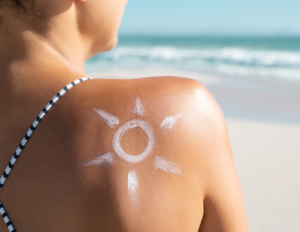UV exposure (ultraviolet radiation exposure) is the root cause of most skin cancers, however there are many safeguards you can take to help #practicesafesun year-round. Skin cancer is the most common cancer in the United States and treatment may involve much more than a mole removal.

Skin cancer – especially melanoma, is the most serious form of the disease and can spread to other part of the body and sometimes become fatal. Melanoma constitutes 1% of skin cancers, but it leads to the majority of skin cancer related deaths. The most common type of skin cancer is basal cell carcinoma followed by squamous cell carcinoma and then melanoma. Thankfully there are many ways you can help lower your risk just in time for UV Awareness month.
Let’s Talk UV
The Ultraviolet (UV) Index is a valuable tool designed to help us make informed decisions about how much time we should spend in the sun and what type(s) of protection we should use. It tells us how strong the sun’s UV rays will be; the higher the UV Index, the greater the strength of the sun’s UV rays and the faster we may experience the damaging effects of overexposure. Today’s technology offers to many of us smart phones and watches that will provide at a touch weather information including the daily UV Index to help make good decisions about time in the sun.

Here are some tips to watch for when seeing the daily UV Index:
- 0 to 2 – Means there is minimal danger for most and you can stay in the sun during peak time (10 am to 2 pm) without burning. You can safely enjoy being outside!
- 3 to 5 – Means there is a low risk. You should opt though to stay in the shade when the sun is the strongest and be sure to wear a broad-spectrum sunscreen (broad-spectrum means it protects against both UVA and UVB rays), protective clothing and sunglasses.
- 5-7 – Means there is a moderate risk and it’s a good time to seeks some shade, slip on a shirt and a wide brim hat, wear UV or polarized sunglasses to protect your eyes and apply sunscreen. Or reapply if you’ve already done so. (Your sunscreen should be reapplied every 2 to 3 hours)
- 8 or higher – Means there is a high risk from unprotected sun exposure. If possible, avoid being outside. And if you must, take some shade breaks and be sure to wear that sunscreen of 30+ SPF or higher, a wide-brim hat and tightly-woven fabric clothing with UPF protection.
We advise patients to be careful being outside especially during peak exposure time of 10 am to 4 pm. When you think about sunscreen look for an SPF of 30 or above and is a broad spectrum sunscreen and to remember to reapply after being outside for a couple of hours. It’s okay to be outside if you protect your skin.
M. Laurin Council, MD
Professor of Medicine, Division of Dermatology

Remember UV rays can pass through holes of loosely knit fabrics and watch out for bright surfaces, like sand, water and snow, which all reflect UB rays and increase your exposure. If you’re headed to the beach, pack an umbrella to provide some shade keeping in mind the suns rays will still penetrate. Spending time in the water? UV rays can reach up to one meter into the water…so applying sunscreen before swimming is a good idea. And when selecting shirts to wear, opt for darker colors as they absorb more UV then lighter colors like white and pastels. A bright red Cardinal shirt will be a better choice for protection than a white one.
Check Your Medicine
Some medicines will come with warning labels to let you know that taking them while being out in the sun can cause changes and sensitivity to your skin. Things like cholesterol and blood pressure medicines, antibiotics, acne medications and more. Medicines should come with a warning label to notify you however if you’re unsure, check with your pharmacist or doctor to be certain.
“Depending on your risk factors, most people over the age of 40, getting a skin check once a year should be sufficient. If you’ve had a skin cancer issue, you would need to be seen more frequently.”
Dr. M. Laurin Council
Three Key things to Remember Daily
- Seek shade when appropriate.
- Wear dark, tightly-woven sun-protective clothing and even better if it offers UPF protection. (protective factor is built into it)
- Apply a broad-spectrum, water-resistant sunscreen with an SPF of 30 or higher. Keep it by your daily care items such as toothpaste or deodorant and make it a routine and apply daily to help limit your exposure.
Remember if you are a sun-lover or just enjoy being outdoors that it’s important to make annual skin screening appointments with your board-certified dermatologist to have an exam of your skin for any changes, new moles or other possible concerns.